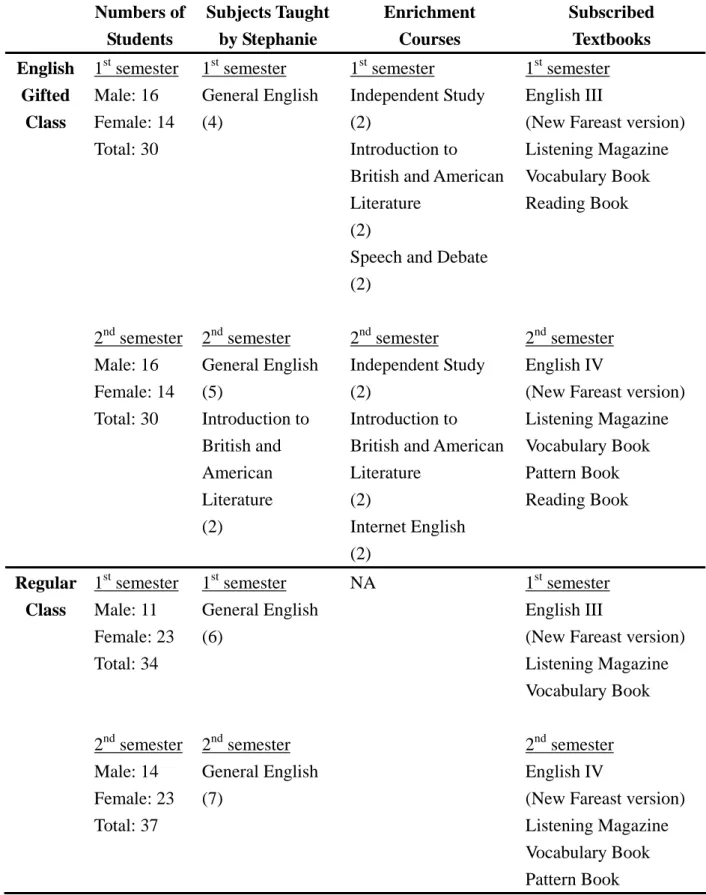CHAPTER THREE METHODOLOGY
This present research is a case study of a senior high school English teacher’s instructional beliefs and curriculum practices in both the English gifted and the regular classes. In this chapter, three qualitative research methods (i.e., classroom observations, interviews, and questionnaire) are delineated. The participants, data collection and analysis of the study are described in sequence.
Participants
The school, target teacher, and classes in the senior high school are discussed in the following section, providing a thorough description of the research site.
The School
For the sake of accessibility, the researcher decided to investigate the English
gifted program in Taipei City. Among several senior high schools where English
gifted programs were offered, the chosen school was deemed by the researcher as the
most appropriate one for this research. This municipal senior high school, located in
the eastern part of Taipei City, was a complete school containing both junior and
senior sections. For senior high section, it approximately consisted of 31 classes,
including 27 regular classes and 4 self-contained gifted classes for English and
physical education talented students. The English gifted program in this school was
relatively new with only a three-year history; that is, there was an English gifted class
in each grade. Teachers in this English gifted program were enthusiastic and earnest
about teaching, even though few of them had sufficient background or qualifications
of gifted education.
The Teacher
This research was a case study intending to investigate a teacher teaching both the English gifted and the regular classes. Thus, after some possible teachers were sifted out, the researcher immediately contacted them through telephone. After suffering from telephone refusals, one of the possible teachers lightened the researcher’s road by granting the help without hesitation. This target teacher, Stephanie
1, had been teaching English in this senior high school for 3 years, among which 2 years were in the English gifted program. After graduating from Department of Foreign Languages and Literatures, National Taiwan University, she started her teaching career in a private girls’ high school in Taipei. In order to enrich herself, Stephanie attended an MA summer TESOL program in the Graduate Institute of English, National Taiwan Normal University. At present, Stephanie has finished all the graduate courses, but the thesis. In total, Stephanie had been teaching English in senior high schools for 8 years.
Concerning specialized teaching areas, Stephanie was interested in and took delight in reading, writing, and speaking instruction. As mentioned earlier, teachers in this English gifted program did not have ample qualifications for educating gifted learners, Stephanie was no exception. However, in the attempt to enrich herself and advance her teaching, Stephanie had participated in some in-service training workshops pertaining to English gifted education several times.
In terms of the target teacher’s perspectives on the English gifted class, she took a positive attitude toward the self-contained mode. As Stephanie noted:
(In a self-contained class), students are at the same level. It is easy for me to design activities in class. And more capable or high-ability learners will provide stimuli for peer learning. But in this kind of class for three years, (students) will become numb, feeling paralyzed gradually to the stimuli.
1
For ethical consideration and protection of the teacher, a pseudonym is used.
(PREOIBG: 12/5/2006)
2As for diplomaism’s impact on English gifted program, Stephanie mentioned that
“diplomaism acutely influences every senior high school student, so let alone English talented learners; they need to choose the road that leads to further studies in colleges”
(PREOIBG: 12/5/2006).
The Classes
In this study, two second-year classes taught by Stephanie were selected as the target classes for observation. The first class, in which Stephanie was the homeroom teacher, was the second-year English gifted class in this senior high school. This self-contained gifted class consisted of 16 male and 14 female students. Among these 30 students, 14 of them were enrolled through the joint entrance screening examination for scholastically gifted students hosted by the city government, whereas 16 were sifted out from within-school identification process. Stephanie had been teaching their “General English” in the previous and present academic years in this English gifted class. In the second observed semester, besides General English, Stephanie also taught “Introduction to British and American Literature,” one of the enrichment courses in this class. In both semesters, in addition to the accelerated
“General English,” the English gifted class had other enrichment courses that were null in the regular class, including “Independent Study,” “Introduction to British and American Literature,” “Speech and Debate,” and “Internet English.” Students in this gifted class were not all interested in social studies; rather, 9 of them belonged to science studies group. What turned out to be was that those belonged to science
2

